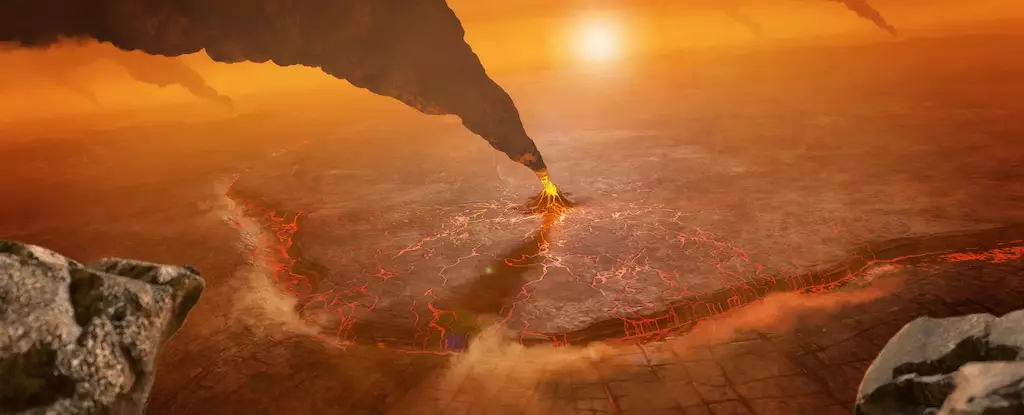For decades, Venus has captivated scientists and enthusiasts alike with its intriguing characteristics and harsh conditions. Traditionally viewed as the “hellish twin” of Earth, its crushing atmospheric pressure and suffocating temperatures have relegated it to a realm of practical and theoretical obscurity. However, new research suggests that the dynamics beneath its inhospitable surface may resemble those found on Earth, challenging our understanding of planetary geology and the classification of our neighboring planet.
Recent analyses of archival data collected from NASA’s Magellan probe unveil intriguing possibilities about the geological processes occurring on Venus. Contrary to the long-held belief that the planet is all but static, this study indicates the presence of dynamic processes that could reshape our comprehension of not only Venus but also the early Earth. This newfound perspective opens a dialogue about the potential similarities in tectonic activities, despite their differences in manifestation.
Understanding Coronae: The Key to Venus’s Interior Dynamics
At the core of this new understanding lies the geological feature known as coronae. These massive, circular structures, which have been mistaken for impact craters in the past, turn out to be indicative of volcanic activity. The current analysis posits that coronae form when plumes of molten rock rise from Venus’s mantle, deforming the surface and creating a dome-like feature that eventually collapses, forming the characteristic ring shape. This cyclical process not only reshapes the surface but also hints at a complex internal system generating heat and material movement.
The research classifies these coronae under a new light, allowing scientists to link them to internal geological processes reminiscent of those found in Earth’s crust. Although Venus lacks tectonic plates similar to Earth, the presence of internal forces pushing upward suggests ongoing tectonic-like activities. The study evokes an interconnectedness between both planets, raising questions about the universality of geological processes across differing planetary environments.
Insights from Data: A New Geophysical Framework
To unravel the mysteries surrounding coronae, scientists utilized a wealth of topographical and gravitational data derived from the Magellan mission. By employing advanced modeling techniques, researchers contrasted various scenarios regarding the formation and significance of these geological features, supporting their claim that Venus is not as geologically dead as once believed.
The findings that 52 out of 75 analyzed coronae correspond to hot, buoyant magma plumes challenge the perception of Venus as a unchanging body. By creating a framework involving both retrogressive geological features and active volcanic processes, the research brings to light the possibility of a dynamic Venus undergoing continuous transformations. The implications hint not only at Venus’s adaptability but also suggest an active geological timeline that could parallel early Earth settings, prior to the establishment of plate tectonics.
Breaking Down the Geological Processes
The geological mechanisms thought to be inspiring the formation of coronae on Venus include processes familiar to Earth, albeit with a twist. One such mechanism is akin to subduction, where materials are forced downward into the mantle due to the push from rising plumes. However, on Venus, this manifests as a spreading of surface materials that ultimately collide, resulting in downward forces—an interplay that could unveil tectonic processes unique to the planet.
Another proposed process is lithospheric dripping, where the layer of the planet’s crust gradually softens and breaks down due to underlying heat, forming droplet-like descents back into the mantle. This intriguing process demonstrates a distinct yet relatable approach to planetary geology and raises questions about the origins and evolution of Venusian surface features.
The Future of Venusian Exploration
Despite the challenges posed by its extreme temperatures and atmospheric conditions, the new findings encourage a more focused approach towards exploring Venus. By examining coronae and their underlying processes, we stand at the threshold of a more comprehensive understanding of the planet’s geological history and its connection to terrestrial processes.
These revelations spark excitement among scientists as they consider the future implications for exploration missions and robotic surveys. Venus may hold keys to not only comprehending its own past but also evaluating the formative years of Earth. As we continue to learn from Venus, we may indeed find ourselves uncovering more than external planetary features; we could discover insights into the fundamental dynamics that govern planetary development across the solar system. The bold endeavor to study this enigmatic neighbor asks for dedicated exploration—and the time is ripe to unveil the hidden stories of Venus’s surface.

